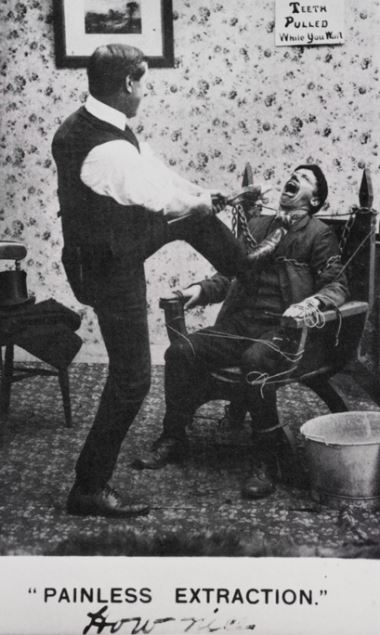Life in the “good old days” wasn’t always so good. For instance, one has to wonder about dental care as practiced by our ancestors. Ready-made toothbrushes and toothpaste were not available until the mid-1800s. Prior to that, everyone had to make their own.
Throughout the Middle Ages, most people simply rubbed salt on their teeth.
Some people made up their own dentifrice and rubbed the resulting powder on their teeth with a small stick, called a "toothstick," with a rag over one end. This was the forerunner of the toothbrush.
By the 1700s medical knowledge improved to the point that doctors began to understand the importance of proper dental care. Toothpaste, properly called dentifrice, was made at home. Here is one such recipe:
…burned hartshorn, powdered oyster shell and white tartar. Also a mouthwash of sal ammoniac and water. Another uses cream of tartar, gum myrrh and oil of cloves. And if all this good dental care fails, you may get a set of artificial ones made from the tusks of the hippopotamus, or sea horse, or from the teeth of some domestick [sic.] animals. Teeth made of ivory or bone soon become discoloured and begin to decay and render the breath offensive.
The above recipe doesn't result in a paste similar to what we squeeze out of tubes today. It apparently creates a dry powder, which is then rubbed onto the rag on the end of a dental stick. Those whose teeth rotted in spite of this care might consider false teeth made from hippo or walrus (“sea horse”) tusks or the bone of some farm animal. This was the best option available to our ancestors – at least, those who had the access and money to obtain it. The reality is that very few could afford such "luxuries." Most of our ancestors simply had their decaying teeth pulled (which I am sure was unpleasant before the invention of novocain) and simply went without false teeth.
I didn't know what hartshorn is, so I looked it up on the web. Several sites mention that it is ammonium bicarbonate or "bakers' ammonia." Before the invention of baking soda and baking powder, hartshorn was used as a leavening agent when making cookies or bread. However, it leaves behind a strong smell of ammonia. Whew!
Here is another recipe for tooth powder, published in 1740:
Use a good tooth powder once a week or once every two weeks for unclean teeth. But the mouth should be rinsed daily after eating with fresh water and scoured with the finger. The tooth powder should not be composed of all rough or all sharp things such as tobacco ashes, powdered coral, pumice stone or brick but should also contain smoothe things such as prepared oyster shell, chalk made from mussels, with a lot of seasoning and flavoring.
Once a week or once every two weeks? Compare that to today's recommendation of brushing your teeth after every meal! And this was before the days of mouthwash, as well.
The first toothbrush would not appear until the more solid toothpaste or tooth soap became available in the 1860s. By the 1880s many druggists were making their own toothpastes, packaged in small tin cans.
 In the Middle Ages, barbers pulled teeth as well as cutting hair. The red and white stripes of a barber pole symbolize the blood that normally was lost during tooth extraction by the barber. Those who claimed to be more skilled at dentistry than their competitors were called "barber-surgeons." These jacks-of-all-trades would not only extract teeth and perform minor surgery, but they also cut hair, applied leeches to let blood, and performed embalming.
In the Middle Ages, barbers pulled teeth as well as cutting hair. The red and white stripes of a barber pole symbolize the blood that normally was lost during tooth extraction by the barber. Those who claimed to be more skilled at dentistry than their competitors were called "barber-surgeons." These jacks-of-all-trades would not only extract teeth and perform minor surgery, but they also cut hair, applied leeches to let blood, and performed embalming.
Dentists did not appear as a separate profession until after 1700. Pierre Fauchard was a French surgeon who became known as the Father of Scientific Dentistry. He wrote a book that was to become the standard reference: "Surgeon Dentist." He recognized the intimate relationship between oral conditions and general health. He advocated the use of lead to fill cavities. Apparently, he did not know about lead poisoning and we can only assume that he poisoned many of his patients. Fauchard died in 1768.
Paul Revere, known for his "midnight ride" in 1775, was by trade a metalworker. While he is best known for creating bowls and other items of silver, he was well-known in Boston for constructing dentures from ivory and gold. George Washington had dentures made of metal and carved ivory or metal and carved cow teeth. Despite modern stories, George Washington never had any teeth made of wood.
Until the mid-1800s, dentures continued to be individually constructed by skilled artisans. Gold, silver, and ivory were common components, causing them to be very expensive and available only to the very wealthy. The poor simply had their teeth extracted and then went without dentures. One can only imagine the difficulty they had with biting and eating once they became middle aged.
Monsieur Geoffroy, president of the Royal Society of Medicine in Paris, wrote in the 1700s, "I declare the success (of my false teeth) is superior to my hopes, I further attest that the teeth of sea horse which I wore for only one year had so much disgusted me by the bad smell that they gave to my breath and the disagreeable smell they communicated to my food ... that I had taken them out to eat!"
In 1844, Dr. Horace Wells, a Connecticut dentist, observed an exhibition of people reacting to inhalation of nitrous oxide (laughing gas). He was the first to use nitrous oxide inhalation during dental therapy and founded the concept of inhalation analgesia and anesthesia. The medical community later adopted inhalation anesthesia as a method of managing pain during surgery.
In 1851 a process to harden the juices of certain tropical plants into vulcanized rubber was discovered. The ability to mold this new material against a model of the patient's mouth and attach artificial porcelain teeth allowed the manufacture of less expensive dentures. This improved technology for creating false teeth benefited millions who could now afford artificial teeth for the first time.
Trying to imagine the lives of our ancestors is always difficult. Typically, we tend to romanticize their lives in a time when life was simpler and moved at a slower pace. Romantic or not, their lives probably were far more difficult than our own. The lack of understanding of simple sanitation rules and the inability to deal with medical issues made many lives uncomfortable, even painful. By the age of twenty, most people had rotten teeth with some teeth already extracted. By the age of fifty, many had lost most or even all of their teeth. One can only imagine how this affected their diets as they were unable to chew their food.
Your ancestor who crossed the ocean, cleared the land for a new homestead, or perhaps fought in wars, may have done so while suffering from tooth pain that we can hardly imagine today.
Perhaps the "good old days" were not as good as we sometimes imagine.
 Latest News Articles
Latest News Articles If you do not see a Plus Sign that is labeled "Add comment," you will need to upgrade to either a (FREE) Standard Edition or a (paid) Plus Edition subscription
If you do not see a Plus Sign that is labeled "Add comment," you will need to upgrade to either a (FREE) Standard Edition or a (paid) Plus Edition subscription